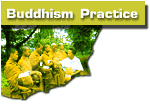 |
BANGKOK
|
||||||||
CENTRAL
|
||||||||||||
NORTHEASTERN
|
||||||||||||||
NORTHERN
|
||||||||||||
SOUTHERN
|
||||
 |
| A GUIDE TO MEDITATION CENTRES IN THAILAND |
| NORTHEASTERN - WAT WAH POO KAEW |
MEANING
OF NAME : |
"Crystal Mountain monastery" |
ADDRESS
: |
Tambon Magluwamai, Amper Sungnoen, Nakhon Ratchasima 30140 |
DIRECTIONS
: |
Located 230 km northeast of Bangkok and 50 km before Nakhon Ratchasima (Korat). Take a bus on the Friendship Hwy. (Hwy. 2) from either city and ask to be let off at Wat Magluwamai (between KM posts 215 and 216); take a songtaew from the junction here south about 15 km to Wat Wah Poo Kaew. From Bangkok, it may be easier to get off at the junction for Sikhiu on the Friendship Hwy. and take a songtaew. Buses in Bangkok leave from the Northern (Moh Chit) Bus Terminal. Some trains stop at Sikhiu. |
MEDITATION
SYSTEM : |
Anapanasati combined with mental repetition of mantra "Buddho." All-around awareness of mind and body is emphasized. Meditators are free to use their own techniques. |
TEACHING
METHOD : |
Ajahn Sutji Anutaro (Thai; age 47) is now the abbot. Retreats for students (mostly high school) take place 2- 3 times a month, lasting 4-5 days; frequently senior monks from surrounding provinces will teach. These retreats increase the noise level, but you can continue your individual practice during them. |
TEACHERS
: |
Luang Paw Pudt (Phra Phawanaphisal Thera) (Thai; age 70) Ajahn Sutji Anutaro, abbot (Thai; age 47) |
LANGUAGE
: |
Lectures and instruction are given in Thai. Visitors must speak at least basic conversational Thai. Theteachers and most monks do not speak English. |
DESCRIPTION
: |
Spread out across a lightly wooded hillside with open areas. Small farming villages occupy the valley below.The wat has 15 rai (6 acres) plus 1,000 rai (400 acres) of government deforested land entrusted to the care of the wat; this land is being replanted in trees. A wooden sala used by the abbot to meet visitors and as the monks' eating area is just inside the entrance. Winding paths lead up the hillside to a large sala where chanting and group meditation take place. Luang Paw Pudt stays in the house farther up the hillside when he visits here. A waterfall is about 2 km from the wat. |
SIZE
: |
monks:
15-35 novices: 3-15 nuns: 0 (no living quarters for nuns) laypeople: a few |
DAILY
ROUTINE : |
4-5:30
a.m. chanting (30 min.) and group meditation; 6 a.m. pindabat for monks and novices; 7:30 a.m. the meal; 3-4 p.m. work period; 4 p.m. drinks; 6-8 p.m. chanting (1 hour) and group meditation. Most of the day is free for individual practice. People try to practice all night on "wan phra." |
FOOD
: |
Very good quality and variety; supplied by pindabat,kitchen, and visiting supporters. One meal is served in the morning; laypeople may keep food for later in the day if they need to. People in this region of Isaan eat mostly white rice, bringing out sticky rice on special occasions. |
ACCOMMODATIONS
: |
The monastery has about 34 kutis, well separated, and 10 large dormitories; nearly all have screens, Thai or Western bathrooms, running water, and electricity. A large, open sala on the hill now serves as the meditation and eating area. |
WRITE
IN ADVANCE? : |
Not necessary; there's usually room. |
OTHER
INFORMATION : |
Local villagers
asked a tudong monk staying at this site to establish a monastery.
Luang Paw Pudt, the abbot of Wat Pah Sarawan in Nakhon Ratchasima,
offered to help. Construction began in 1980 on land donated by a villager.
The Forestry Department donated additional land in 1987 and the monastery
became official the following year. Very suitable for experienced meditators who wish to practice in a quiet monastery environment. Laypeople normally observe 8 precepts. Information about Wat Wah Poo Kaew can be obtained from the main monastery if you're in Nakhon Ratchasima. Wat Pah Sarawan, once surrounded by jungle, is now enveloped by the city; it's located south of the railway station; easiest way thereis by samlor. |
| Select here : |
|
|